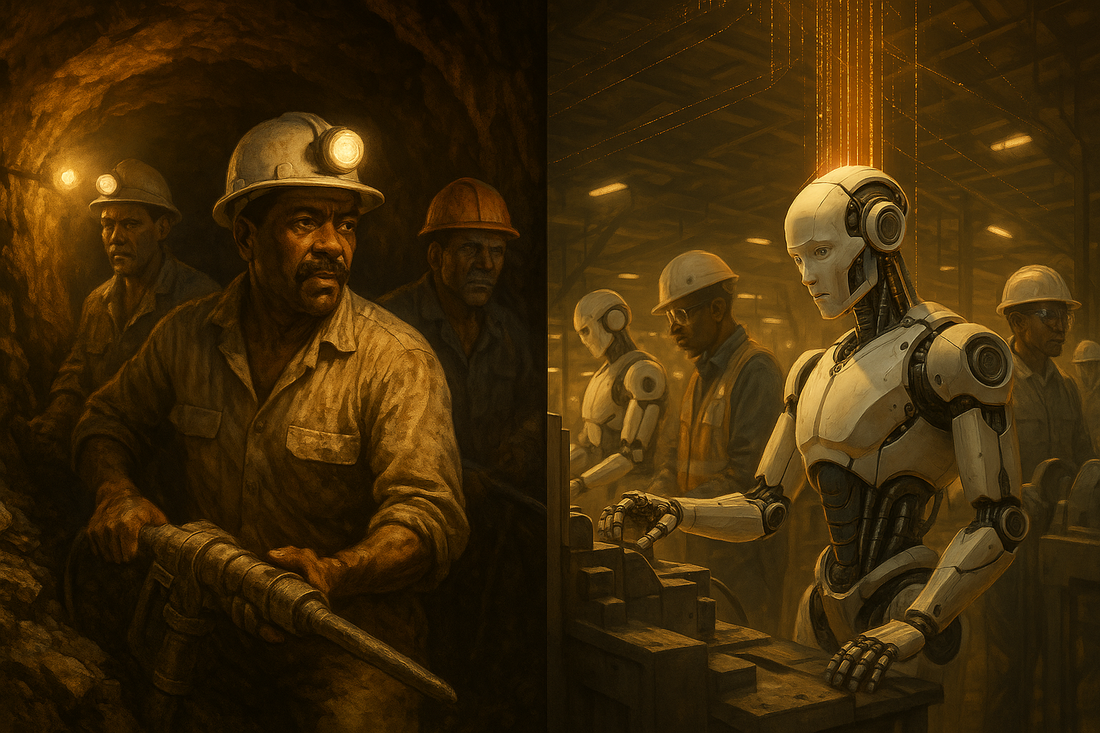
Beyond the Chatbot Hype: Why Physical AI Will Define South Africa's Next Economic Revolution
What if the most important AI breakthrough of 2025 isn't happening on your smart device, but in the physical world around you?
Whilst the technology press obsesses (guilty!) over agentic AI systems and their ability to write better emails, a far more profound revolution is unfolding in warehouses, mines, and factories across the globe. Physical AI—embodied intelligence that can perceive, reason, and act in the real world—is rapidly emerging as the technology that will fundamentally reshape how work gets done.
And for South Africa, with our mining heritage, manufacturing base, and agricultural potential, this represents perhaps the most significant economic opportunity since the discovery of gold.
The Numbers: A R550 Billion Revolution
The global embodied AI market tells a story of explosive growth that dwarfs most technology trends. From a modest R84 billion in 2025, the market is projected to reach R550 billion by 2030—representing a staggering 39% compound annual growth rate that outpaces even the early days of mobile computing.
To put this in perspective: if 2024 was the year of talking AI, 2025 is definitively the year of walking AI. The International Federation of Robotics reports that integrating analytical, generative, and physical AI is enabling robots to handle complex, non-repetitive tasks with unprecedented agility. Unlike their programmed predecessors, today's physical AI systems learn through experience, adapting their approach based on previous successes and failures.
The implications are staggering. These autonomous systems can now perform tasks that double in complexity every seven months—a progression that mirrors Moore's Law and suggests we're witnessing the early stages of an exponential transformation.
Beyond Our Digital Obsession (some of us are just starting to prompt)
Whilst American tech giants pour billions into chatbots and virtual assistants, companies worldwide are quietly deploying physical AI systems that deliver measurable, immediate value. Tesla's Optimus humanoid robot refines its manufacturing skills in simulated factory environments before deploying on actual production lines. Boston Dynamics' Atlas navigates industrial sites with near-human precision, identifying and manipulating objects in dynamic environments.
Perhaps most telling: venture capital firms are increasingly funding startups pursuing advanced robotics over purely digital solutions. Companies like Physical Intelligence, Skild AI, and 1X Technologies represent a fundamental shift in investor priorities—from software that thinks to systems that act.
NVIDIA's Cosmos platform, unveiled at CES 2025, exemplifies this transformation. Rather than focusing on text generation, Cosmos processes vast amounts of real-world sensory data, training robots to balance, grip objects, and move dynamically through unpredictable environments.
Our South African Opportunity: Our Industrial Advantage
For South Africa, physical AI represents more than technological advancement—it's economic salvation disguised as innovation. Our unique industrial profile positions us perfectly to capitalise on embodied intelligence applications that other economies cannot replicate.
Consider our mining sector, where physical AI systems could revolutionise operations through autonomous drilling, ore sorting, and equipment maintenance. These applications address South Africa's specific challenges: dangerous working conditions, skilled labour shortages, and operational efficiency requirements that pure software solutions cannot touch.
Agricultural applications offer equally compelling opportunities. Physical AI systems capable of crop monitoring, harvesting, and livestock management could transform farming productivity whilst addressing rural employment through human-machine collaboration rather than replacement.
Manufacturing presents perhaps the greatest potential. With production costs rising globally, South African manufacturers equipped with physical AI systems could compete internationally through enhanced precision, reduced waste, and 24/7 operational capability.
The Infrastructure Reality Check
However, capitalising on physical AI requires foundational capabilities that extend beyond robot deployment. The technology demands what experts call "AI-ready data"—information optimised specifically for artificial intelligence applications. Currently, 57% of organisations globally estimate their data isn't AI-ready, creating bottlenecks that prevent effective implementation.
For South African companies, this represents both challenge and opportunity. Those investing now in data infrastructure, model operationalisation capabilities, and AI-native engineering practices will capture disproportionate advantages as physical AI systems become mainstream.
The sustainability dimension adds another layer of complexity and opportunity. Physical AI systems must operate efficiently within environmental constraints whilst contributing to carbon reduction goals. South Africa's renewable energy transition could position us as leaders in sustainable embodied intelligence—robots powered by solar and wind rather than coal-dependent grids.
The Trust and Risk Imperative
Physical AI introduces risks that purely digital systems cannot match. When AI makes mistakes in spreadsheets, we lose time. When physical AI systems malfunction, we risk human safety, equipment damage, and operational disasters.
This reality demands sophisticated Trust, Risk, and Security Management (TRiSM) frameworks that govern AI behaviour in physical environments. South African companies implementing physical AI must prioritise safety protocols, human oversight mechanisms, and fail-safe systems that protect both workers and equipment.
The regulatory landscape remains fragmented, with existing frameworks inadequate for governing autonomous systems that interact with the physical world. Early adopters must develop their own governance standards whilst anticipating future regulatory requirements.
The Economic Transformation Ahead
Physical AI represents the next fundamental leap in technological capability—comparable to how mobile computing transformed digital experiences by untethering us from our desktops. Embodied intelligence will similarly liberate AI from screen-based limitations, enabling autonomous systems to create value through direct physical interaction with the world.
For South Africa, the choice is stark: embrace physical AI leadership or risk permanent technological dependency as other nations capture the value of embodied intelligence applications.
The window for strategic positioning remains open, but it's closing rapidly. Companies and policymakers who recognise physical AI's transformational potential—and invest accordingly—will shape South Africa's economic future for decades.
The revolution isn't coming through chatbots or virtual assistants. It's walking through factory doors, mining tunnels, and agricultural fields right now. The question isn't whether physical AI will transform South African industry—it's whether we'll lead that transformation or simply experience it.
